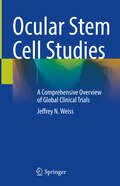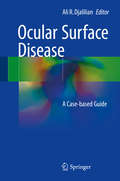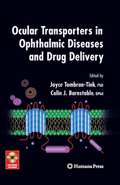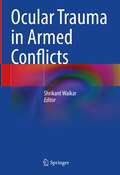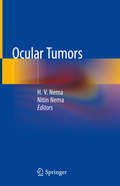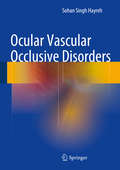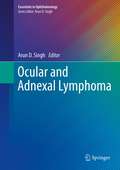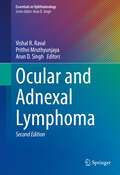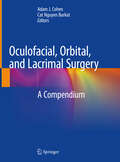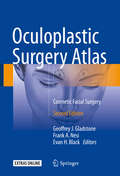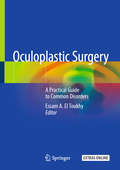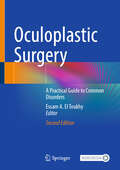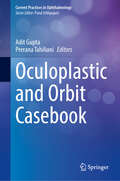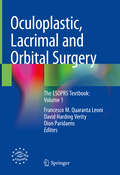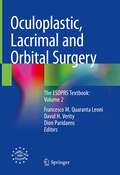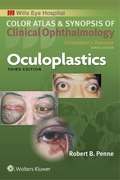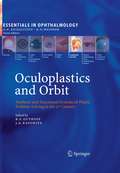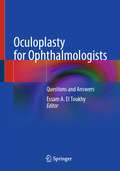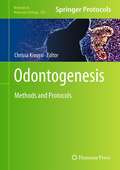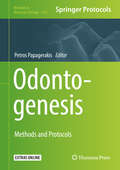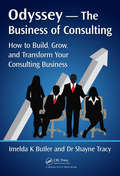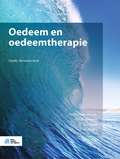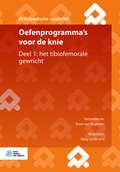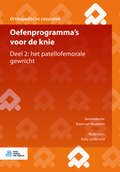- Table View
- List View
Ocular Stem Cell Studies: A Comprehensive Overview of Global Clinical Trials
by Jeffrey N. WeissThis book is a compendium of the worldwide ocular stem cell studies registered with clinicaltrials.gov. The study title is provided, along with the country of origin and the clinical trial number in order to make it easier for the reader to locate the study and obtain further information. An analysis of the type of stem cell utilized and study support is also provided. The final section deals with issues encountered by the stem cell researchers. Ocular Stem Cell Studies: A Comprehensive Overview of Global Clinical Trials is a valuable resource for ophthalmologists, optometrists, other physicians, and researchers.
Ocular Surface Disease
by Ali R. DjalilianThis book provides a concise review of the latest diagnostic and therapeutic strategies for effective management of patients with ocular surface diseases (OSD), ranging from the very common dry eyes and tear film disorders to the more severe epithelial diseases such as limbal stem cell deficiency. The role and application of both medical and surgical treatments are carefully explained, covering, for example, current medical approaches to dry eye disease, ocular graft versus host disease, and chronic cicatricial conjunctivitis, the use of contact lenses in management of OSD, amniotic membrane transplantation, limbal transplantation, cell-based therapies, and use of the Boston keratoprosthesis (KPro). The book is intended for optometrists and ophthalmologists, in practice or in training, who are seeking an update on the more advanced clinical practices. The chapters are authored by clinical experts in the field who share a wealth of practical knowledge and pearls that will be useful to any practitioner.
Ocular Transporters in Ophthalmic Diseases and Drug Delivery
by Colin J. Barnstable Joyce Tombran-TinkIn this exceptionally important new work, a panel of distinguished authors discusses all the latest developments in the study of ocular transporters. Focusing on the molecular characteristics, localization, and substrate specificities in various compartments of the eye, this volume discusses how transporters regulate the clarity of the cornea and lens, the movements of fluids across the ciliary epithelium and nutrients across the retinal pigment epithelium.
Ocular Trauma in Armed Conflicts
by Shrikant WaikarThe book comprehensively covers the complete spectrum of ocular trauma in war and peace, while most of the books on ocular trauma cover only civil trauma. It explains the care to be taken by the injured himself from the time of injury to the most specialized tertiary care management step-by-step. It covers the various modes of trauma, the evaluation, and the management from emergency care and evacuation to secondary and tertiary care. The initial chapters cover the step by step care of wounds and the application of dressings or tourniquets available in the battlefield to be taken by the individual himself and the initial medical care by forward medical officer and surgeon before evacuating to the ophthalmologist The book also covers the management of polytrauma involving the head and neck or other parts of the body based on real-life experience since most of the battlefield ocular trauma presents with it. It incorporates chapters on ocular trauma due to chemical, biological, radiological or nuclear (CBRN) hazards and the important aspect of imaging in ocular trauma. It covers the classification systems of ocular trauma. The book presents the step-by-step approach to primary repair of open globe injuries and lid lacerations by the first contact ophthalmologist. It covers the subspeciality wise tertiary care management of ocular trauma, encompassing an approach to the management of corneal scars, lenticular injuries, uveitis, traumatic glaucoma, intraocular foreign body and other posterior segment manifestations of injury like retinal detachment, vitreous and choroidal hemorrhage, etc., orbit and optic nerve trauma and other neuroophthalmological manifestations of trauma. It also includes a chapter on chemical injuries and techniques of stem cell transplantation for ocular surface reconstruction. Additionally, it covers the management of unsalvageable eyes and cosmetic rehabilitation. The book is a complete and helpful resource on ocular trauma and assists ophthalmologists, trauma care workers, and medical officers with security forces in the easy management of ocular trauma.
Ocular Tumors
by H. V. Nema Nitin NemaThe book covers practically all tumors of eye and adnexa. Chapters are contributed by well- established ocular oncologists of India. It describes retinoblastoma, malignant melanoma and lymphoma in some detail while covering tumors of lids and conjunctiva briefly. Separate chapters are devoted to the pathology of retinoblastoma, genetics of retinoblastoma and malignant melanoma. Each chapter is profusely illustrated. The book provides state-of-the-art knowledge needed to diagnose ocular cancers in the early stage and to treat them effectively. The book meets the curriculum of postgraduate studies of the Indian Universities. It will be very useful for students who are preparing for MD, MS, DNB and FRCS examinations. The book will assist practicing ophthalmologists in early diagnosis and treatment of ocular tumors.
Ocular Vascular Occlusive Disorders
by Sohan Singh HayrehThis book provides a comprehensive account of the pathogenesis, clinical features, and management of ocular vascular occlusive disorders, with the focus very much on the scientific evidence. This offers a sound basis for addressing the many controversies that surround these disorders, which collectively constitute the most common cause of visual impairment or blindness. The book is divided into two sections, the first of which addresses the basic science and encompasses vascular anatomy, blood supply and flow, and retinal tolerance time to acute ischemia. The second, clinical, section covers the presentation, clinical features, diagnosis, and treatment of the full range of vascular occlusive disorders of the retina, the choroid, the anterior segment of the eye, ophthalmic manifestations of carotid artery disease and the optic nerve. Ocular Vascular Occlusive Disorders, written by a distinguished world leader in the field, will be invaluable for general ophthalmologists, and particularly for retina specialists, neuro-ophthalmologists, and researchers.
Ocular and Adnexal Lymphoma
by Arun D. SinghThis book - a conjoint effort of ocular oncologists, general oncologists, and pathologists - is a comprehensive source of authoritative information on the subject of ocular and adnexal lymphoma. It covers all aspects, including clinical features, classification, epidemiology, diagnostic evaluation, biopsy techniques, histology and molecular pathology, staging procedures, and treatment methods. Detailed information is provided on primary vitreoretinal and adnexal lymphomas and chapters are also included on rare variants such as T cell lymphoma and reactive lymphoid hyperplasia of the ocular adnexa. The emphasis throughout is on easy readability, and the layout ensures rapid retrieval of information. In order to convey fundamental concepts, numerous tables, clinical photographs, histopathologic microphotographs, and imaging studies (fluorescein and indocyanine angiograms, ultrasonograms, CT scans, and MR images) are included.
Ocular and Adnexal Lymphoma (Essentials in Ophthalmology)
by Arun D. Singh Vishal R. Raval Prithvi MruthyunjayaThis book is a comprehensive source of authoritative information on the subject of ocular and adnexal lymphoma. It is a completely updated edition of its predecessor and is a conjoint effort of ocular oncologists, general oncologists, and pathologists. The book features contributions from around the world to ensure broad coverage of an evolving topic. Chapters cover all aspects of ocular lymphomas, including clinical features, classification, epidemiology, diagnostic evaluation, biopsy techniques, histology and molecular pathology, staging procedures, and treatment methods. The emphasis throughout is on easy readability, and the layout ensures rapid retrieval of information. The book offers a clear distinction of what has been updated in the years since the first edition published, including entirely rewritten or revamped chapters. In order to convey fundamental concepts, numerous tables, clinical photographs, histopathologic microphotographs, and imaging studies (fluorescein and indocyanine angiograms, ultrasonograms, CT scans, and MR images) are included.Ocular and Adnexal Lymphoma strives to cover new developments and innovations in ocular and adnexal lymphoma, providing the clinician with a review and summary of recent research and its implications for clinical practice and explaining how research results impact diagnostics, treatment options and procedures as well as patient management.
Oculofacial, Orbital, and Lacrimal Surgery: A Compendium
by Adam J. Cohen Cat Nguyen BurkatThis comprehensive text covers both core and advanced principles within oculofacial, orbital, and lacrimal surgery with extensive detail not found in any other current book on the subject. Richly illustrated with hundreds of images,Oculofacial, Orbital, and Lacrimal Surgery: A Compendium is written and edited by international leaders in fields spanning ophthalmology, otolaryngology, oral and maxillofacial surgery, and plastic surgery. Covering topics such as embryology, anatomy, and physiology of the lacrimal system, imaging for orbital diseases and thyroid-related ophthalmology, and flap geometry and planning, this book is an excellent resource for those in training, as well as seasoned clinicians looking to stay current. This book is divided into five sections: Eyelid, Oculofacial, Lacrimal, Orbit, and Socket, with each section containing detailed chapters addressing evaluation, imaging, and various surgical approaches and management.Designed to not only provide an anatomical and surgical guide for all three types of surgeries, but to help physicians avoid mistakes and correct complications of patients referred to them, Oculofacial, Orbital, and Lacrimal Surgery: A Compendium is the definitive, authoritative reference on this complex field.
Oculoplastic Surgery Atlas
by Evan H. Black Geoffrey J. Gladstone Frank A. Nesihe desire to teach and the fulfillment attained from teaching T have again prompted us to produce a work that we hope will be both useful and enlightening to our readers. The field of oculoplastic surgery has grown and evolved to include all aspects of eyelid and facial plastic surgery. Our literature must now reflect the advancements and direction of our field. Knowledge of anatomy, the basis of all surgery and the root of surgical princi#65533; pIes and techniques, is the basis of our ability to deli ver the highest#65533; quality care to our patients. We have therefore combined text and diagrams, and supplemented them with CD-ROM digital video technology to provide to those who wish to perform this surgery the best possible instruction and prepa#65533; ration. We hope that our attempts to accomplish this will be rewarded by the use of our material by our colleagues and the acknowledgment of our unique and logical progression in the field of eyelid and facial plastic surgery. Future volumes in this series will cover other aspects of eyelid, lacrimal, facial, and orbital surgery.
Oculoplastic Surgery Atlas: Eyelid and Lacrimal Disorders
by Evan H. Black Geoffrey J. Gladstone Frank A. Nesihe desire to teach and the fulfillment attained from teaching T have again prompted us to produce a work that we hope will be both useful and enlightening to our readers. The field of oculoplastic surgery has grown and evolved to include all aspects of eyelid and facial plastic surgery. Our literature must now reflect the advancements and direction of our field. Knowledge of anatomy, the basis of all surgery and the root of surgical princi#65533; pIes and techniques, is the basis of our ability to deli ver the highest#65533; quality care to our patients. We have therefore combined text and diagrams, and supplemented them with CD-ROM digital video technology to provide to those who wish to perform this surgery the best possible instruction and prepa#65533; ration. We hope that our attempts to accomplish this will be rewarded by the use of our material by our colleagues and the acknowledgment of our unique and logical progression in the field of eyelid and facial plastic surgery. Future volumes in this series will cover other aspects of eyelid, lacrimal, facial, and orbital surgery.
Oculoplastic Surgery: A Practical Guide to Common Disorders
by Essam A. El ToukhyOculoplastic Surgery: A Practical Guide to Common Disorders provides guidance on various clinical approaches for treating oculoplastic disorders as well as ocular trauma. In addition, highly illustrated and informative chapters examine the interaction between oculoplasty, ophthalmic sub-specialties (pediatrics, cataract, refractive, neuro, glaucoma) and other clinical areas including ENT, maxillofacial, dermatology, general plastic surgery and psychiatry. Consultants, surgeons, trainees and health professionals from all the specialties and sub-specialties related to oculoplasty, will find this book to be an indispensable resource for further developing skills and knowledge in the field of oculoplastic surgery.
Oculoplastic Surgery: A Practical Guide to Common Disorders
by Essam A. El ToukhyThis book provides guidance on various clinical approaches for treating oculoplastic disorders as well as ocular trauma. Highly illustrated and informative chapters examine the interaction between oculoplasty, ophthalmic sub-specialties (pediatrics, cataract, refractive, neuro, glaucoma) and other relevant clinical areas throughout the chapters. Oculoplastic Surgery: A Practical Guide to Common Disorders, 2nd Edition has been fully revised where required with the latest insights and research featuring new chapters on corneal neurotization, lacrimal disorders, reconstruction of the complicated socket and the psychological aspects of lid anomalies and scars. Consultants, surgeons, trainees and health professionals from all the specialties and sub-specialties related to oculoplasty, will find this book to be an indispensable resource for further developing skills and knowledge in the field of oculoplastic surgery.
Oculoplastic and Orbit Casebook (Current Practices in Ophthalmology)
by Adit Gupta Prerana TahilianiThe book provides case-based approach to learning oculoplastic and orbit pathologies and tumors. It is divided into 4 categories; eyelid, orbit, lacrimal and aesthetics. Each category covers 5-10 commonly seen clinical conditions elaborated in a lucid way to understand the clinical approach and plan management of the condition. Chapters also cover the recent advances in the field.The book is helpful for ophthalmology residents, oculoplasty fellows, practicing ophthalmologists, vision science researchers and general ophthalmologists.
Oculoplastic, Lacrimal and Orbital Surgery: The ESOPRS Textbook: Volume 1
by Francesco M. Quaranta Leoni David Harding Verity Dion ParidaensOculoplastic, Lacrimal and Orbital Surgery: The ESOPRS Textbook informs the reader of recent insights and new developments in the fields of ophthalmic plastic, lacrimal and orbital surgery. This textbook is relevant to readers preparing for the EBO-ESOPRS examination, but will also be of interest to residents and fellows in ophthalmology, plastic surgery, dermatology and all specialists with an interest in oculoplastic, lacrimal and orbital surgery. Volume 1 is divided into three sections: the first section includes chapters on functional eyelid disorders, the second section examines rejuvenation of the periorbital region and the third is on lacrimal disorders. For further reading, please see Volume 2 of the textbook, which explores socket surgery, diseases of the orbit and thyroid associated orbitopathy.
Oculoplastic, Lacrimal and Orbital Surgery: The ESOPRS Textbook: Volume 2
by Francesco M. Quaranta Leoni Dion Paridaens David H. VerityOculoplastic, Lacrimal and Orbital Surgery: The ESOPRS Textbook informs the reader of recent insights and new developments in the fields of ophthalmic plastic, lacrimal and orbital surgery. This textbook is relevant to readers preparing for the EBO-ESOPRS examination, but will also be of interest to residents and fellows in ophthalmology, plastic surgery, dermatology and all specialists with an interest in oculoplastic, lacrimal and orbital surgery. Volume 2 is divided into three sections: the first section includes chapters on socket surgery, the second section examines diseases of the orbit and the third is on thyroid associated orbitopathy. For further reading, please see Volume 1 of the textbook, which explores functional eyelid disorders, rejuvenation of periorbital region and lacrimal disorders.
Oculoplastics (Color Atlas and Synopsis of Clinical Ophthalmology)
by Robert PennePublisher's Note: Products purchased from 3rd Party sellers are not guaranteed by the Publisher for quality, authenticity, or access to any online entitlements included with the product. Developed at Philadelphia’s world-renowned Wills Eye Hospital, the Color Atlas and Synopsis of Clinical Ophthalmology series covers the most clinically relevant aspects of ophthalmology in a highly visual, easy-to-use format. Vibrant, full-color photos and a consistent outline structure present a succinct, high-yield approach to the seven topics covered by this popular series: Cornea, Retina, Glaucoma, Oculoplastics, Neuro-Ophthalmology, Pediatrics, and Uveitis. This in-depth, focused approach makes each volume an excellent companion to the larger Wills Eye Manual as well as a practical stand-alone reference for students, residents, and practitioners in every area of ophthalmology.
Oculoplastics and Orbit
by Rudolf F. Guthoff James A. KatowitzThe 8 recurring volumes of the "Essentials in Ophthalmology" series cover the most recent developments in one of eight subspecialties in Ophthalmology. With four volumes published per year, each subspecialty is newly visited every 24 months, with a distinct focus on recent developments. By bridging the gap between original research and medical textbooks, the transfer of this developing knowledge into daily practice is greatly enhanced.
Oculoplasty for Ophthalmologists: Questions and Answers
by Essam A. El ToukhyThis book is a concise, easy-to-use multi-choice question and answer resource in oculoplasty for ophthalmologists undertaking exams in this sub-specialty. Each chapter contains a short didactic summary of the topic followed by MCQs and answers. References to the full-text book Oculoplastic Surgery: A Practical Guide to Common Disorders are also included in the answer section of each chapter. This unique format allows readers to dip into MCQs to practice for exams while also providing clear references of where to find chapters from a larger text.This book includes MCQs that examine the interaction between oculoplasty, ophthalmic sub-specialties (pediatrics, cataract, refractive, neuro, glaucoma) and other clinical areas including ENT, maxillofacial, dermatology, general plastic surgery and psychiatry. Consultants, surgeons and trainees from all ophthalmic specialties and sub-specialties will find this book to be an indispensable resource for exam revision in oculoplasty.
Odontogenesis
by Chrissa KioussiOnly in recent times has the possibility of growing and implanting replacement teeth, made from one's own cells, moved into the realm of realistic possibilities; however, the molecular and cellular mechanisms of tooth development must be studied in a range of vertebrates, from zebrafish to mice, so that evolutionarily conserved network kernels, which will define the cellular states of generic vertebrate tooth development, can be recognized. In Odontogenesis: Methods and Protocols, experts in the field examine techniques to approach this burgeoning field. This detailed volume includes chapters on the detection of "tooth development" gene expression, both at the RNA and protein level, current approaches to the manipulation of gene expression levels and subsequent analysis of tooth phenotypes, as well as chapters concerning current efforts to get living tooth implants working without waiting for a full understanding of the developmental pathways at the molecular level. Written in the highly successful Methods in Molecular BiologyTM series format, chapters include introductions to their respective topics, lists of the necessary materials and reagents, step-by-step, readily reproducible laboratory protocols, and tips for troubleshooting and avoiding known pitfalls. Practical and easy to use, Odontogenesis: Methods and Protocols aims to help researchers move forward toward the ultimate goal of getting a "bioengineered tooth" into the patient's mouth.
Odontogenesis: Methods and Protocols (Methods in Molecular Biology #1922)
by Petros PapagerakisThis volume provides methods and approaches to study genetic and environmental regulatory controls on odontogenesis. Chapters guide readers through protocols for isolation and characterization of both epithelial and mesenchymal dental cells, methods on isolation, phenotypic characterization, expansion, differentiation, immunofluorescence, in situ hybridization, immunohistochemistry, imaging protocols, rodent dental fluorosis model, 3D assessment of crown size, dental diseases models, next generation sequencing, genetic and epigenetic studies, genome-wide association studies as well as clinical protocols for measurement of early childhood caries and saliva, and supragingival fluids and biofilm collection and subsequent analyses. Written in the highly successful Methods in Molecular Biology series format, chapters include introductions to their respective topics, lists of the necessary materials and reagents, step-by-step, readily reproducible laboratory protocols, and tips on troubleshooting and avoiding known pitfalls. Authoritative and cutting-edge, Odontogenesis: Methods and Protocols aims to guide researchers towards elucidating the secrets and mysteries of a fascinating and unique organ, the tooth.
Odyssey --The Business of Consulting: How to Build, Grow, and Transform Your Consulting Business
by Imelda K. Butler Shayne TracyThis book provides consultants with a career framework to build, grow, and transform their consulting businesses by becoming brilliant at the basics. The Odyssey process challenges current thinking and offers a methodology to help readers rise to the top of the profession by applying leading-edge techniques and methodologies.An ideal companion to t
Oedeem en oedeemtherapie
by H.P.M. Verdonk N. Devoogdt R. J. DamstraDit boek biedt een totaalbeeld van oedeem en gaat uitgebreid in op de diagnostiek, de evaluatie en de belangrijkste therapievormen. Het is een studieboek én naslagwerk en richt zich primair op fysiotherapeuten, kinesitherapeuten, huidtherapeuten en dermatologen. Ook is het geschikt voor flebologen, geriaters, verpleegkundigen, sportmasseurs en studenten fysiotherapie, kinesitherapie en huidtherapie. Oedeem en oedeemtherapie is in deze derde druk geheel nieuw van opzet en heeft een meer totale benadering. Ook zijn in alle hoofdstukken de nieuwste inzichten en technieken verwerkt, zoals de toepassing van zorgmodellen bij chronische aandoeningen, en nieuwe beeldvorming in de functionele diagnostiek. De rode draad wordt gevormd door de international classification of functioning, disability and health (ICF). Onderwerpen als anatomie, (patho)fysiologie van het lymfesysteem, het veneuze systeem, microcirculatie, diagnostische methodes en genetica komen aan de orde. Verder gaat het boek in op conservatieve behandelvormen zoals huidverzorging, compressietherapie, oefentherapie, manuele lymfedrainage, zelfmanagement en diëtetiek. Ook bespreekt het de operatieve technieken en de medicamenteuze behandeling. Vele illustraties ondersteunen de inhoud. De redactie bestaat uit prof. Nele Devoogdt (fysiotherapeut/kinesitherapeut), Bert Verdonk (fysiotherapeut) en dr. Robert Damstra (dermatoloog). Zij zijn gespecialiseerd in diagnostiek en behandeling van chronisch oedeem. Ook zijn ze verbonden aan het European Reference Network voor primair en pediatrisch lymfoedeem en aan de expertisecentra voor lymfoedeem in Nederland en België.
Oefenprogramma's voor de knie: Deel 1: het tibiofemorale gewricht (Orthopedische casuïstiek)
by Koos Van Nugteren Patty JoldersmaDit boek beschrijft en illustreert oefenprogramma’s voor de behandeling van de meest voorkomende vormen van kniepathologie in het tibiofemorale gewricht. (Sport)fysiotherapeuten, kinesitherapeuten en oefentherapeuten kunnen er hun kennis mee opfrissen, of er passende knieoefeningen voor patiënten in vinden. Door de overzichtelijke opbouw is het boek bovendien erg geschikt als leerboek voor aankomende professionals. Oefenprogramma’s voor knieaandoeningen beschrijft van iedere aandoening een voorbeeldcasus met daarbij de symptomen en de belangrijkste bevindingen van het functieonderzoek. Zo wordt duidelijk hoe de aandoening te herkennen is. Vervolgens leest u de meest actuele informatie over de aandoening en algemene informatie over de behandeling. Ten slotte wordt een oefenprogramma beschreven. De oefeningen kunnen, eventueel in aangepaste vorm, vaak ook gebruikt worden als huiswerkoefeningen voor patiënten. Achterin het boek staan vier bijlagen over de juiste uitvoering van het functieonderzoek en de toegevoegde tests. Het boek bevat 428 illustraties. Dit is uitgave 28 van de serie Orthopedische Casuïstiek. Tweemaal per jaar verschijnt er een nieuw deel in deze serie. De serie is ook online beschikbaar op abonnementsbasis. Dit deel is geschreven onder redactie van Patty Joldersma (sportfysiotherapeut en fitnesstrainer) en Koos van Nugteren (fysiotherapeut).
Oefenprogramma's voor de knie: Deel 2: het patellofemorale gewricht (Orthopedische casuïstiek)
by Koos Van Nugteren Patty JoldersmaDit boek beschrijft en illustreert oefenprogramma’s die kunnen worden gegeven bij veelvoorkomende aandoeningen van het patellofemorale gewricht. De oefeningen kunnen, eventueel in aangepaste vorm ook gebruikt worden als huiswerkoefeningen. Het boek bevat meer dan 250 illustraties. Van iedere aandoening wordt een voorbeeldcasus beschreven met daarbij de symptomen en belangrijkste bevindingen van het functieonderzoek. Zo wordt duidelijk hoe de aandoening is te herkennen. De juiste uitvoering van het functieonderzoek en de toegevoegde tests zijn achterin het boek te raadplegen in vijf rijk geïllustreerde bijlagen. (Sport)fysiotherapeuten, kinesitherapeuten en oefentherapeuten kunnen ‘Oefenprogramma’s voor knieaandoeningen, patellofemorale gewricht’ gebruiken om hun kennis op te frissen. Daarnaast is het een naslagwerk om passende knieoefeningen voor patiënten te vinden. Door de overzichtelijke opbouw is het boek bovendien geschikt als leerboek voor opleidingsdoeleinden. Dit is uitgave 29 van de serie ‘Orthopedische Casuïstiek’. Tweemaal per jaar verschijnt er een nieuw deel in deze serie. De serie is ook online beschikbaar op abonnementsbasis. Het voorgaande boek uit de serie van ‘Orthopedische casuïstiek’ was getiteld: Oefenprogramma’s voor knieaandoeningen, deel 1: tibiofemorale gewricht. Samen met dit voorgaande boek bevatten de twee boeken een waardevolle verzameling oefeningen die kunnen worden gebruikt bij aandoeningen van het kniegewricht voor de minder mobiele oudere tot en met de actieve topsporter. Deze uitgave in de serie ‘Orthopedische Casuïstiek’ is geschreven onder redactie van Patty Joldersma (sportfysiotherapeut en fitnesstrainer) en Koos van Nugteren (fysiotherapeut).
